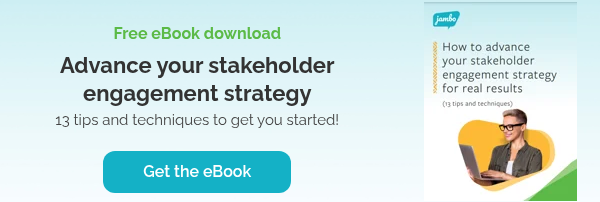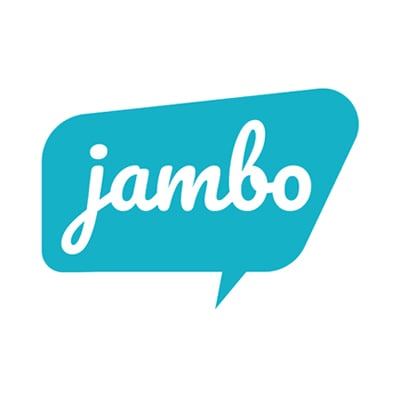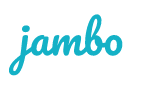.jpg?height=410&name=Improving-your-change-management-process-with-Stakeholder-Relationship-Management-software-(SRM).jpg)
Que votre organisation mette en œuvre de nouvelles technologies ou modifie ses objectifs, la gestion du changement peut être un processus complexe comportant de nombreuses étapes.
La façon dont vos parties prenantes perçoivent votre processus de gestion du changement peut varier. Si vous ne répondez pas aux préoccupations liées à la gestion du changement par un engagement clair et transparent, la situation peut rapidement devenir incontrôlable en raison de rumeurs et de suppositions qui brisent la confiance et érodent les relations importantes avec les parties prenantes.
Dans le blog d'aujourd'hui, nous allons vous expliquer comment inclure l'engagement des parties prenantes dans votre projet de gestion du changement et comment notre logiciel de gestion des relations avec les parties prenantes (SRM), Jambo, peut vous aider à gérer le processus de gestion du changement de manière plus efficace et efficiente.
Dans ce blog
Qu'est-ce que la gestion du changement ?
Pourquoi l'engagement des parties prenantes est-il important efficacective du changement ?tion efficace du changement ?
Comment les relations avec les parties prenantes sont-elles gérées pendant le changement ?
5 étapes critiques à prendre en compte pour les parties prenantes pendant le changement
Comment le logiciel de gestion des relations avec les parties prenantes Jambo vous aide-t-il ?
Qu'en est-il des autres outils de gestion du changement ?
Dites bonjour à Jambo
Qu'est-ce que la gestion du changement ?
La gestion du changement est une discipline qui fournit des cadres et des méthodes pour gérer la façon dont une organisation transforme ses processus, ses outils ou ses structures. L'objectif principal est de s'assurer que les changements sont effectués en douceur et avec succès, avec un minimum de résistance et un maximum d'engagement de la part des personnes concernées. Cela implique souvent une planification claire, une communication forte, l'implication des dirigeants et un soutien continu pour aider les personnes à passer de leurs méthodes de travail actuelles à de nouvelles méthodes.
Pourquoi l'engagement des parties prenantes est-il important pour une gestion efficace du changement ?
Les parties prenantes de votre projet de gestion du changement comprennent toutes les personnes concernées par le changement :
- Salariés
- Partenaires
- Entrepreneurs
- Organes de régulation
- et plus
Grâce à un engagement réfléchi et opportun et à une approche structurée, vous pouvez obtenir le soutien et la compréhension de toutes les parties prenantes, ce qui est essentiel pour la réussite de votre projet de gestion du changement. Cependant, le changement n'est pas toujours confortable ou bien accueilli, et la résistance de certaines parties prenantes à votre processus de gestion du changement est inévitable, c'est pourquoi il y a quelques étapes critiques à prendre en compte.
Pour en savoir plus sur les trois raisons pour lesquelles les relations avec les parties prenantes sont essentielles à la réussite de votre organisation, consultez notre blog !

Comment les relations avec les parties prenantes sont-elles gérées pendant le changement ?
Le modèle ADKAR est un outil puissant pour mener à bien la gestion du changement en se concentrant sur les parcours individuels à travers le changement. Chez Jambo, nous pensons que la gestion des relations avec les parties prenantes à chaque étape du modèle ADKAR (Awareness, Desire, Knowledge, Ability, and Reinforcement ) garantit des transitions plus douces et un soutien plus fort pour vos projets.
En communiquant clairement les raisons du changement, en motivant l'adhésion, en fournissant les bonnes informations, en dotant les parties prenantes des compétences nécessaires et en renforçant les progrès, votre équipe peut établir une confiance durable et maintenir les initiatives de changement sur la bonne voie. Avec Jambo, vous pouvez gérer ces étapes critiques de manière transparente, en rendant chaque étape du changement plus efficace et plus centrée sur les parties prenantes.
5 étapes critiques à prendre en compte pour les parties prenantes lors d'un changement
1. Cartographie des parties prenantes
Qui sera concerné par les changements ?
Les parties prenantes internes et externes doivent être prises en compte. Essayez donc de réfléchir à toutes les personnes susceptibles d'être affectées par ces changements.
L'utilisation a carte des carte des parties prenantesclasse les parties prenantes en fonction de leur niveau d'intérêt et d'influence dans le contexte de votre projet et de sa réussite.
Vous êtes novice en matière de cartographie des parties prenantes ? Consultez notre blog sur la manière de réaliser un exercice de cartographie des parties prenantes.
Vous pouvez utiliser cette catégorisation pour vous aider à décider des tactiques d'engagement.
2. Formes de communication
Prenez le temps de réfléchir aux meilleurs moyens de communiquer avec vos parties prenantes :
- Intranet ?
- Courriel ?
- Appel vidéo ?
- Appel téléphonique ?
- Réunions en face à face ?
Toutes les parties prenantes n'ont pas besoin du même niveau de communication (par exemple, une annonce sur l'intranet conviendra à certains, mais pas à tous). De même, toutes les parties prenantes ne réagiront pas de la même manière aux différentes formes de communication.
Prenez le temps de déterminer comment vous communiquerez avec chaque groupe de parties prenantes et n'oubliez pas de faire preuve de souplesse si vous devez apporter des changements.
Quelle que soit votre décision, les formes de communication utilisées doivent être claires et faciles à contrôler.
3. Le leadership
Pour que votre processus de gestion du changement soit efficace, vous devez identifier les leaders qui guideront la gestion des efforts d'engagement des parties prenantes. Ces responsables doivent être dignes de confiance, accessibles et bien informés.
Décidez des rôles que joueront les dirigeants et qui sera responsable de la communication avec chaque groupe de parties prenantes. Réfléchissez aux responsables qui seront les personnes de contact désignées au cours du processus de gestion du changement et à la manière dont les parties prenantes les contacteront.
Ce sont des questions auxquelles vous devez répondre avant de commencer à communiquer avec vos parties prenantes.
4. Les messages clés
Identifiez vos messages clés dès le départ afin de garantir une communication claire et cohérente. Cette clarté et cette cohérence permettront d'éviter la confusion due à des messages contradictoires et de faire en sorte que les parties prenantes disposent dès le départ des informations essentielles dont elles ont besoin.
Tout d'abord, vous devez comprendre clairement l'objectif que votre organisation tente d'atteindre en mettant en œuvre les changements, puis définir les messages clés qui l'expliquent à vos parties prenantes d'une manière compréhensible.
Il est essentiel de formuler les choses avec soin, car vos choix peuvent avoir un impact sur la façon dont vos parties prenantes percevront le processus ; prenez donc le temps d'élaborer des messages réfléchis. Toute personne impliquée dans le processus en tant que responsable doit être au courant des messages clés et de toute modification apportée à ces messages.
5. Quel est le plan ?
Les parties prenantes se sentent davantage responsabilisées lorsqu'elles reçoivent des informations pertinentes et honnêtes sur les changements à venir le plus tôt possible dans le processus.
Avant de commencer à vous engager, assurez-vous d'avoir un plan et un calendrier pour communiquer les changements à venir.
Veillez toujours à ce qu'il y ait une boucle de retour d'information, afin que les parties prenantes sachent à qui s'adresser en cas de problèmes ou de questions. Vous ne vous engagez pas vraiment avec vos parties prenantes si elles ne peuvent pas contribuer à la conversation.
Lorsque les parties prenantes savent quand elles peuvent s'attendre à recevoir des communications et à qui elles peuvent s'adresser pour poser des questions, elles se sentent intégrées, ce qui réduit la probabilité qu'elles se tournent vers le redoutable moulin à rumeurs pour obtenir des informations.
La communication est essentielle et il est primordial de disposer du bon outil.
Une fois votre plan mis en place, comment organiserez-vous, gérerez-vous et suivrez-vous l'ensemble de vos communications et l'engagement des parties prenantes ?
Si vous ne suivez pas correctement toutes vos communications avec les parties prenantes, vous risquez de ne pas savoir ce qu'elles disent et de ne pas avoir la possibilité de résoudre rapidement les problèmes éventuels. Cela peut avoir un impact négatif sur la réussite de votre processus de gestion du changement et conduire à des ruptures dans les relations avec les parties prenantes.
Pour s'assurer que les parties prenantes reçoivent les bonnes informations, au bon moment, de la part des bonnes personnes, le logiciel de gestion des relations avec les parties prenantes (SRM) est un outil que vous pouvez utiliser pour gérer l'ensemble de vos engagements avec les parties prenantes dans un espace unique et facile à comprendre.
Pour savoir comment un logiciel de gestion des relations avec les parties prenantes (SRM) peut aider votre organisation, consultez notre blog !
Un SRM peut aider toutes les personnes impliquées dans le processus de gestion du changement à rester au fait de toutes les communications avec les parties prenantes, de manière collaborative et intentionnelle. Les chefs de projet peuvent s'assurer que les messages clés sont utilisés, vérifier qui a été ou n'a pas été contacté, ainsi que l'état d'avancement de toute question concernant les parties prenantes. Si l'objectif est de réussir la mise en œuvre du changement, il s'agit d'un outil utile.

Comment le logiciel de gestion des relations avec les parties prenantes de Jambo peut aider
Avec des flux de travail conçus spécifiquement pour gérer les informations et les efforts d'engagement des parties prenantes, notre SRM, Jambo, rend la gestion et l'organisation de l'engagement des parties prenantes pendant la gestion du changement simple et facile - il minimise les perturbations.
Voici quelques exemples de l'aide apportée par Jambo :
a. Suivi
Lorsqu'il s'agit de gestion du changement, des engagements seront sans aucun doute pris envers les parties prenantes.
Les engagements (que l'on pourrait appeler des promesses) nécessitent un suivi. Si vous ou un membre de votre équipe oubliez de donner suite à un engagement pris auprès d'une partie prenante, la confiance que vous aviez avec cette personne se désintégrera rapidement, ce qui est risqué car la confiance est essentielle dans la gestion du changement.
N'oubliez pas qu'il faut des années pour construire la confiance, mais seulement quelques secondes pour la détruire.
Avec le module d'engagements de Jambo, vous pouvez facilement visualiser tous les engagements (actuels et passés). Vous pouvez également rechercher des engagements par contact de partie prenante, ce qui est très utile si vous allez parler avec eux et que vous voulez vous assurer que vous êtes à jour sur toutes les promesses que vous ou votre équipe avez faites.
b. Tout documenter
Avec Jambo, votre processus de contribution est simplifié et rationalisé. Avec toutes vos communications et informations sur les parties prenantes dans un système unifié et organisé, vous pouvez comprendre ce que les gens disent pour mieux décider de ce qui fonctionne et de ce qui doit être changé.
Avec toutes vos informations dans le système, vous pouvez exécuter des rapports pour mieux comprendre votre projet, vous permettant d'approfondir des points spécifiques tels que le nombre de problèmes ouverts ou une vue d'ensemble du projet qui peut être facilement partagée avec la direction et les principales parties prenantes.
c. Cartes intégrées
Les cartes intégrées de Jambo vous aident à comprendre visuellement vos activités d'engagement des parties prenantes et à suivre les domaines de préoccupation. Ceci est utile si plusieurs sites géographiques sont impliqués dans le projet.
d. Balisage
Le système de marquage unique de Jambo vous permet d'attribuer des étiquettes personnalisées aux parties prenantes et aux enregistrements d'engagement afin de mieux suivre et d'identifier les tendances dans vos données.
Les étiquettes jouent un rôle essentiel lorsque vous souhaitez suivre des parties prenantes spécifiques. Vous pouvez ajouter des balises aux parties prenantes critiques pour les identifier en fonction de leur importance, de leurs préoccupations, de leurs intérêts, etc. Vous pouvez également filtrer et rechercher vos étiquettes pour trouver tous les engagements avec les personnes étiquetées et produire des rapports à leur sujet.
e. Questions
Lorsqu'il s'agit de mettre en œuvre un changement, des questions concernant les parties prenantes ne manquent pas de se poser, et elles doivent être traitées aussi rapidement et avec autant de tact que possible.
Grâce au module des problèmes de Jambo et à la chronologie des problèmes facile à comprendre, vous pouvez surveiller tous les problèmes actuels ou antérieurs qui ont été soulevés et comprendre leur impact et leur priorité.
Cela permet de s'assurer que vous ne manquerez jamais d'essayer de résoudre un problème. Vous aurez accès à un calendrier indiquant toutes les communications avec les parties prenantes liées au problème, ce qui est essentiel lorsque vous essayez d'instaurer et de maintenir la confiance des parties prenantes et qui est crucial pour faire avancer votre projet de gestion du changement.
Qu'en est-il des autres outils de gestion du changement ?
1. Utiliser des feuilles de calcul pour gérer les communications relatives à la gestion du changement
Les feuilles de calcul ne sont pas idéales pour gérer l'engagement des parties prenantes, car elles deviennent rapidement trop compliquées et désordonnées, ce qui est problématique lorsque vous essayez d'organiser et de gérer des informations essentielles.
Souvent, il s'agit d'abord d'une feuille de calcul, mais elle se transforme rapidement en cinq ou dix feuilles de calcul, voire plus. Lorsque les informations sont réparties dans plusieurs feuilles de calcul, le recoupement des informations complique rapidement l'examen et l'établissement de rapports sur les informations essentielles.
En outre, dans le cadre d'un projet de gestion du changement, où plusieurs personnes doivent avoir accès aux données pour les saisir et les partager, les feuilles de calcul peuvent devenir trop compliquées et même constituer un risque pour le projet en raison des lacunes potentielles dans les données (dues à des méthodes de saisie incohérentes ou à une mauvaise organisation).
Les tableurs ne font plus l'affaire ? Consultez notre blog pour découvrir les 10 raisons pour lesquelles il est temps de rompre avec les feuilles de calcul.
2. Utilisation d'un logiciel de gestion des relations avec la clientèle (CRM) pour gérer les communications relatives à la gestion du changement
Disposer du bon logiciel pour vous aider à rester organisé est crucial pour le succès de votre organisation.
Bien qu'ils présentent certaines similitudes avec les MRS, les CRM sont conçus pour gérer les clients et les ventes, et non les parties prenantes. Cela signifie que les flux de travail et la nomenclature sont différents, ce qui peut être à la fois déroutant et coûteux, et avoir un impact considérable sur l'efficacité de l'outil. À l'inverse, les MRS sont conçus pour les parties prenantes, avec des flux de travail pour soutenir leur engagement.
Vous voulez en savoir plus sur la différence entre les MRS et les CRM? Consultez notre blog !
Principaux enseignements
|
Dites bonjour à Jambo
Jambo est le moyen le plus rapide et le plus facile pour les organisations et les départements gouvernementaux de gérer leurs informations sur les parties prenantes, leurs communications avec les parties prenantes et leurs projets d'engagement des parties prenantes.
En ces temps de changement, les projets de gestion du changement deviennent de plus en plus populaires dans toutes les industries. Jambo aide les responsables de projets de gestion du changement à résoudre les nombreux défis uniques auxquels ils sont confrontés.
Pour en savoir plus sur Jambo et sur la façon dont il peut simplifier l'engagement des parties prenantes de votre organisation, réservez un appel de 15 minutes avec un expert Jambo !










